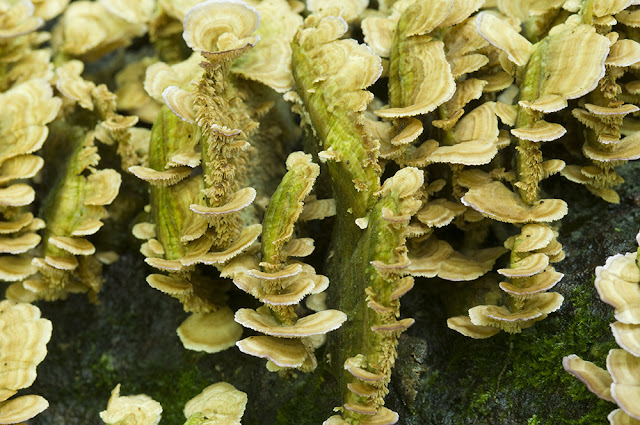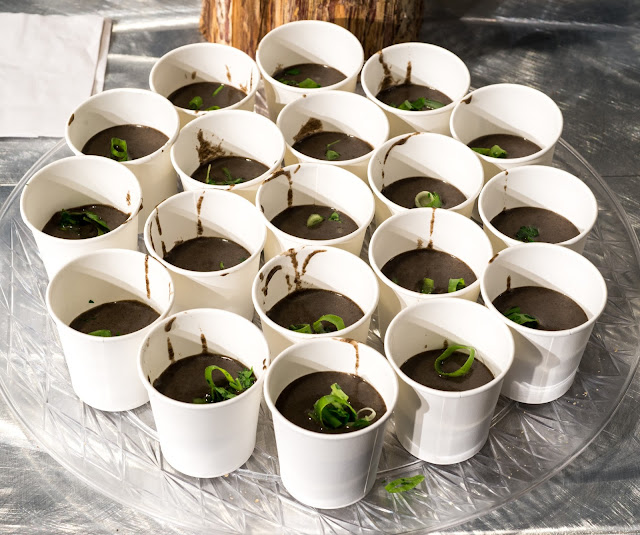Even thought spicebush berries and acorns are wild foods collected in autumn, hot summer days are when we want ice cream sandwiches. Dipping into our preserved stores, we pulled spicebush berries and finely ground acorn flour from the freezer and put together a summertime treat. I had originally made a similar sauce for bread pudding using the spicebush berries, and thought it would make a nice custard-based ice cream. Thinking about how to serve the ice cream, I attempted to make ice cream cones from acorn flour, but ended up with thin cookies that worked better as sandwich cookies.
The flavor of the ice cream is similar to Indian kulfi, exotically spiced and warming with hints of cardamom and black pepper, all from our local, native spicebush berry,
Lindera benzoin. We collected acorns from white oaks three years ago when they were abundant, cold leached them in water for a few weeks before drying and grinding them into flour. Hopefully this year will be a good mast year for the local white and red oaks, and we can collect many bucketfuls of acorn to shell over the winter months!
 |
| Spicebush berry ice cream |
Spicebush Ice Cream Sandwiches on Acorn Cookies
makes about 9-10 sandwiches
For the sandwich cookies:
Acorn Cookies makes about 18- 2" cookies
1/2 c. all purpose flour
1/4 c. ground acorn flour
1/2 c. powdered sugar
1/4 tsp. salt
2 egg whites
1/2 tsp. water
5 Tbsp. butter, melted and cooled
1 Tbsp. vanilla
1. Preheat oven to 300°F, and cover a cookie sheet with parchment paper.
2. In a bowl, whisk the flour, acorn flour, powdered sugar, and salt together until blended.
3. In another bowl, beat the egg whites and water together until frothy, and whisk in the cooled, melted butter and vanilla.
4. Using a large wire whisk, blend the dry ingredients into the eggs and whisk until combined.
5. Scoop about 1 Tbsp. of the batter onto the parchment covered cookie sheet, and use a small spatula to spread it out into a 2-3 inch round, about 1/8" thick. This will not spread very much in the oven, so leave about 1" between each cookie round on the cookie sheet.
6. Bake for 8 minutes, until firm, remove from the oven and prick the tops of the flat cookies with a fork gently to make some decorative holes. Cool cookies, they will be slightly soft and flexible.
For the ice cream:
Spicebush Berry Ice Cream makes about 1 gallon
2 c. whole milk or almond milk
2 c. heavy cream
About 40 spicebush berries
1 c. granulated sugar, divided
1/4 tsp. salt
5 large egg yolks
2 tsp. vanilla extract
1. Have the bowl of the ice cream maker frozen and ready to use.
2. In a blender, blend the spicebush berries and whole milk or almond milk until the berries are ground into small specks.
3. In a medium saucepan over medium heat, whisk together the milk, ground berries, cream, 1/2 cup of the sugar, and the salt. Slowly bring the mixture to a boil.
4. As the milk mixture is heating, combine the yolks and remaining 1/2 cup of sugar in a bowl. Whisk until the yolks are light yellow and thick.
5. Once the milk/cream mixture has just stated to boil, whisk about 1/3 of it into the yolk mixture. Add another 1/3 of the hot milk to the yolks, then add it all back into the saucepan. Using a rubber spatula or wooden spoon, stir the mixture over low heat for 3-5 minutes, until the custard thickens and coats the back of the spoon. Do not let the custard come to a boil or the yolks will be overcooked.
6. Pour the custard through a fine mesh strainer to catch any lumps and stir in the vanilla extract. Cover and chill.
7. Follow the manufacturer's directions for your ice cream machine, and churn the custard until thickened, about 20 minutes. Transfer to a freezer container and chill until firm.
8. Once the ice cream is firm, scoop 2-3 Tbsp. onto an acorn cookie, and top with another acorn cookie. Re-chill until firm.
 |
| Acorn flour |


















































